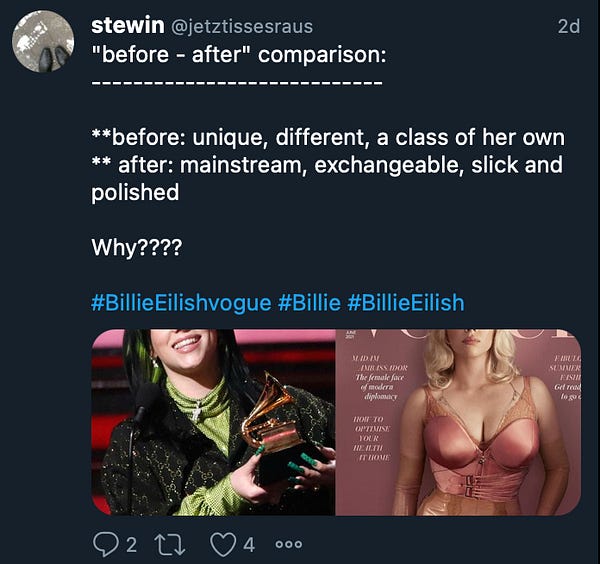What we write when we write about tweets
Digital media relies on overworked writers and random Twitter users.
Welcome to Embedded, your essential guide to what’s good on the internet, published Monday through Friday by Kate Lindsay and Nick Catucci. “Get Embedded” on Twitter and Instagram. 🧩
Yesterday, a tweet about Billie Eilish and The New York Times awoke my digital media PTSD. —Kate
One of the biggest freedoms that has come with this newsletter is not having to pretend anything is more important than it actually is. We have no quotas, no click goals, and no one’s going to get laid off if they underperform, so I don’t have to wake up and scramble to write something that’s going to break our little corner of the internet. But it’s hard to get used to, because I have spent nearly a decade in an industry where that is not the case.
Yesterday, VICE News correspondent Roberto Aram Ferdman tweeted a New York Times analysis of Billie Eilish's British Vogue cover (speaking of breaking the internet). The story claimed that “not everyone” was happy about the pop star’s decision to don lingerie. Ferdman pointed out that “not everyone” is actually a single tweet from a German Twitter account with only three followers. From that, the NYT extrapolated an entire backlash to the singer.





This horrified me not because of the writer's harmful exaggeration (or archaic ideas about cultural consensus, as Ryan Broderick argued in yesterday's Garbage Day), but because I’ve done something like this maybe a hundred times.
Until recently, my career was writing for women’s pop culture websites, churning out three to seven stories every day. But if there’s one thing women's pop culture websites like more than content, it’s access. When I was assigned a story about Ariana Grande getting what seemed to be a culturally appropriative tattoo, my draft was handed back to me with the instruction to find some tweets to support that idea. We couldn’t be the ones saying she was appropriating, because maybe one day she’d do an interview with us (she never has), so instead I had to find other people saying it and point to them.
The thing is, few people were saying this. This wasn’t the big controversy our headline was making it out to be. In fact, I found only one tweet claiming it was. It was thoughtful and from a real person—perfect!—so I threw it in there and we published the story. And when the person who wrote that tweet saw our story, they thought, understandably, that we had ripped off their idea. I didn’t know how (and wouldn’t have been allowed, anyway) to explain how their tweet even ended up in this article.
A true explanation would have gone something like this: I have to write five stories a day, so if I scrap one, I need to rush to replace it to keep proving my value (get clicks) because there are layoffs every six months at this publication and we live in a country where healthcare is tied to employment and I’m on medication, so this tweet was essentially a life raft all because we couldn’t just fucking say ourselves that Ariana Grande probably shouldn’t have gotten a tattoo in botched Japanese.
I was recently asked if I thought newsroom leaders were aware of the amount of stress their writers were under. The thing is, I knew for a fact that the person who assigned me the story was also under pressure. And that whoever told her that this story needed tweets before she could publish it was doing so under the thumb of someone above them. You can just keep pointing up, up, up until you get to the much more complicated answer: There’s no big bad villain causing any of this. It’s just the result of a decade of learned toxic productivity, trickling down to a single, stupid, embedded tweet.
Recommended in this post: Who Are The People In The Trend Pieces? by Ryan Broderick in Garbage Day.


